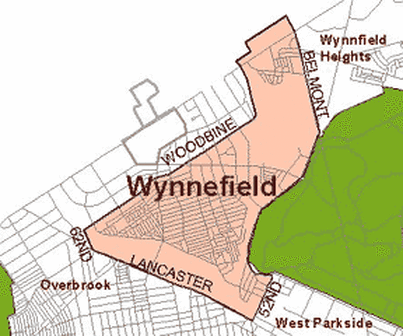ABOUT OUR NEIGHBORHOOD
Wynnefield is a diverse middle-class neighborhood in West Philadelphia. Its borders are 53rd Street at Jefferson to the south, Philadelphia's Fairmount Park to the east, City Avenue (commonly referred to as "City Line") to the north and the Amtrak Main Line tracks to the west.
Surrounding neighborhoods include Bala Cynwyd to the north, Wynnefield Heights and Belmont Village to the east, Parkside to the south, and Overbrook to the west.[1] Its main commercial arteries are North 54th Street, Bryn Mawr Avenue (2200 block), and City Avenue.It is the home of the television station WPHL-TV (MY PHL 17). It also has connections to the motion picture industry. Wynnefield is the childhood home of actor and rapper Will Smith, film producer Lee Daniels ("Monster's Ball" and "The Woodsman"), film director Charles Stone III, politico and documentary filmmaker Tigre Hill.
Wynnefield is one of Philadelphia’s most widely recognized neighborhood names. The neighborhood is known for its many beautiful single homes, its active community organization, and its racial diversity. A portion of St. Joseph’s University is located within the boundaries of this neighborhood, and commercial development exists in three areas: on City Avenue, along 54th Street, and near the intersection of Bryn Mawr and Wynnefield Avenues. Wynnefield is defined by City Avenue and Fairmount Park, and the Bala Golf Club and Cardinal Avenue. Local politicians with Wynnefield ties include former Philadelphia mayors Michael Nutter, and Wilson Goode, City Councilman Curtis Jones, Jr, and Councilmember Katherine Gilmore Richardson.
Our population is about 16,000. The value of single family homes is above the norm for West Philadelphia in all sections of Wynnefield, but there is considerable variation in housing values within this diverse neighborhood. Residential development is greater in the row home vicinity of 54th & Berks than in the area near City Avenue where large, stately detached homes exist similar to those in the smaller adjoining neighborhoods of Overbrook Farms and Green Hill Farms. Wynnefield is a highly desirable place to live in Philadelphia.
Wynnefield is named for Thomas Wynne (1627-1692)
who immigrated from Caerwys, North Wales and became the personal physician to William Penn.
Thomas Wynne was one of a large group of Quakers who settled Philadelphia. His family house, Wynnestay, remains standing in Wynnefield on Woodbine Avenue. Some say it was the first stone-built house in the state of Pennsylvania. (You history buffs might also want to know that Pennsylvania comes from the Welsh word for “head” which is “pen” with a single “n.” It does not, it seems come from William Penn’s own name). Since Welshman were very influential in early Philadelphia, the influence of the Welsh language is clear all over our area. Note town names like Bala Cynwyd, Gladwyne et al.
It is said that when William Penn learned that Philadelphia’s major east-west streets had been named after the most prominent men in town:
Claypoole, Holme, Songhurst and the Welshman, Thomas Wynne, his Quaker sensibilities were offended. Penn decreed that streets should not be named for men but for “the things that spontaneously grow in the country.” By the end of 1684, Claypoole became Walnut Street, Holme became Mulberry (now Arch) Street, Songhurst became Sassafras (now Race) Street, and Thomas Wynne’s street became Chestnut Street.

WYNNEFIELD HISTORY
Dr. Thomas Wynne (July 20, 1627 -March 17, 1691) was personal physician of William Penn and one of the original settlers of Philadelphia in the Province of Pennsylvania. Born in Caerwys (Flintshire)Wales, where his family dated back fifteen generations, he accompanied Penn on his original journey to America on the ship Welcome.
The fourth of five sons of Thomas Wynne Sr., Thomas Wynne lost his father at the age of 11. While attracted to the study of medicine early on. Heavy taxes levied on his family originally made the acquisition of proper learning materials difficult. He was able to make the acquaintance of an established surgeon by the name of Richard Moore, and soon he was able to apprentice until he was deemed worthy of licensing.
Born into the Protestant faith, in 1655 at the age of 28 he married a Quaker, Martha Buttall (1627-1676), and found himself profoundly converted. Henceforth a devout Quaker and author of several pamphlets on Quaker doctrine, Wynne faced persecution and even six years’ imprisonment in England in the 1680s. After his first wife Martha died, he married Mrs. Elizabeth Rowden (b. 1637; d. after 1691) on July 20, 1676, and she accompanied him as he joined Penn on his trip to America, leaving on August 30 and landing on October 27, 1682.
Wynne was notable for erecting the first brick house in the colony, his “Liberty Lot” on Front and Chestnut streets (known as Wynne Street until renamed by Penn in 1684). He built a home on 52nd Street and Woodbine Avenue in 1690 named “Wynnestay” (a pun on the name of the famous Wynnstay estate in Wales), and several surrounding communities now bear his name. He served as speaker for the first two Pennsylvania Assemblies of the Province in Philadelphia in 1687 and 1688 and acted as Justice of Sussex county, now a county in Delaware, from 1687-1691.
He followed Penn back to England on his trip in 1684. He was appointed a justice of the peace in January 1690 and held the position of justice of the provincial court from September 1690 until his death. His time in America lasted only nine years. He is buried at the Friends meeting house at Fourth and Arch Streets in Philadelphia.
 |  |  |
|---|---|---|
 |  |

